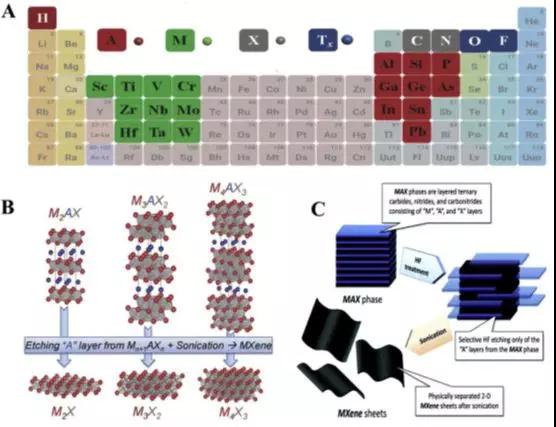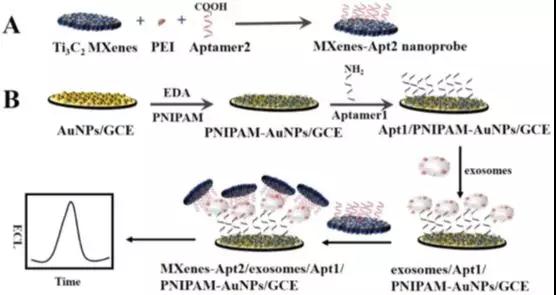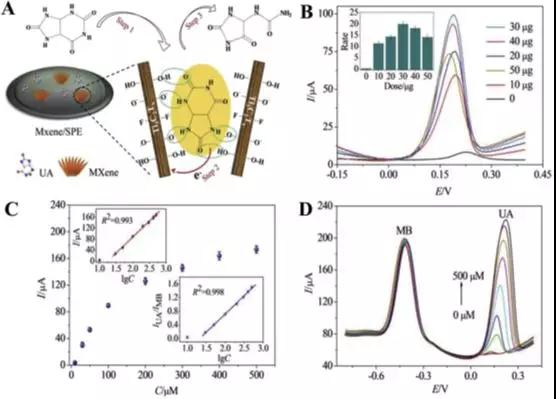
hotline:
17715390137
Tel/Wechat:
18101240246 (Technology)
0512-68565571
Email:mxenes@163.com (Sales Engineer)bkxc.bonnie@gmail.com
Scan the code to follow or search the official account on WeChat:
2D Materials Fronrier After paying attention,
click on the lower right corner to contact us,
Enter enterprise WeChat.
Professional Services Online


【Research Background】
Two-dimensional materials have aroused great interest due to their unique physical, chemical, and electrical properties. These characteristics make them suitable for energy storage, catalysis and electronic applications. MXenes is a new two-dimensional transition metal carbide, nitride or carbonitride first produced by Professor Gogotsi and colleagues in 2011. Since its discovery, due to its unique layered morphology, high electrical conductivity, high surface area, excellent hydrophilicity, good thermal stability and environmental protection characteristics, it has attracted widespread attention in the scientific and industrial circles. These unique characteristics make MXenes have broad application prospects in the fields of energy storage, catalysis and electronics, environmental restoration and sensing. MXene has good electrical conductivity, due to its surface has (-OH, -O and -F) and other functional groups have high hydrophilicity, good ion insertion behavior, easy to functionalize, and reliable large-scale production. Ideal material for high-performance electrochemical (bio) sensors.
[Achievement Profile]
Recently, Professor Huang Yunhui of Huazhong University of Science and Technology published a research paper titled: Recent advances in MXene-based electrochemical sensors and biosensors in the internationally renowned academic journal Trendsin Analytical Chemistry. First, the synthesis, exfoliation and modification / function of MXenes are provided in the article. Methods and discuss their advantages and disadvantages. Then it focuses on the application of MXene in the structure of electrochemical (biological) sensors, and focuses on the detection of different types of substances. Based on the analysis results, the review is divided into three parts. The relative electrochemical performance, linear dynamic range, sensitivity, and stability according to LOD are explained. And compared with the literature report, the advantages and disadvantages of MXene sensor were studied. Finally, the current challenges and future research opportunities of MXenes in electrochemical sensors are described.
[Picture and text guide]

Figure 1. Existing MAX phase and MXene synthesis methods.

Figure 2. Performance characterization of a dielectricless H2O2 biosensor using Nafion / Hb / Ti3C2 / GCE.

Figure 3. Shows the structure of the developed biosensor and its applications in glucose, lactate, and pH detection.

Figure 4. Surface characterization of functionalized MXene.

Figure 5. Schematic diagram of the synthesis of MXene-Apt2 nanoprobes and corresponding MXenes-Apt2 / exosomes / Apt1 / PNIPAM-AuNPs / GCE biosensors for exosome detection.

Figure 6. MXene-based microfluidic chip fabrication principle and its application in Cre, UA, urea detection.

Figure 7. MXene / SPE UA detection schematic and performance diagram.

Figure 8. Surface and electrochemical characterization of MXene / SPE.

Figure 9. Schematic synthesis of MnO2 / Mn3O4 and MXene / AuNPs composites and the synthesis of AChE-Chit / MXene / AuNPs / MnO2 / Mn3O4 / GCE biosensors for methamidophos detection.
[Summary of this article]
This article reviews the unique physical, chemical, and structural properties of MXenes and their nanocomposites and their applications as electrochemical (bio) sensors in clinical biomarkers, therapeutic agents, and the environment. This paper systematically discusses the related properties of electrochemical in terms of detection limit, dynamic range, sensitivity, and its practical applications. It is worth noting that the stability of the MXene-based enzyme sensor is very good because it has a unique accordion-like structure that can effectively immobilize the enzyme and provide a favorable microenvironment for the enzyme to maintain its biological activity. High electrical conductivity, large surface area, good component variability, and good hydrophilicity are suitable for the construction of electrochemical sensing devices; therefore, MXenes, as a sensitive electrochemical sensor, can detect a variety of analytes and has a broad Application prospects. After careful literature review, it was found that MXenes-based electrochemical (bio) sensors have been effectively used to detect a considerable number of analytes. Specifically, the detection limit of the environmental pollutant MXene sensor is in the picomolar to femtomol range, which is far superior to traditional detection methods such as spectrum and chromatography. However, reports on the quantification of pharmaceutical preparations are limited and require more attention as new therapeutics are being developed on a regular basis. Of course, there are many problems in the application of MXene in sensors, such as synthesis methods and oxidation problems.
Literature link:
https://doi.org/10.1016/j.trac.2019.115643.

| Reminder: Beijing Beike New Material Technology Co., Ltd. supplies products only for scientific research, not for humans |
| All rights reserved © 2019 beijing beike new material Technology Co., Ltd 京ICP备16054715-2号 |